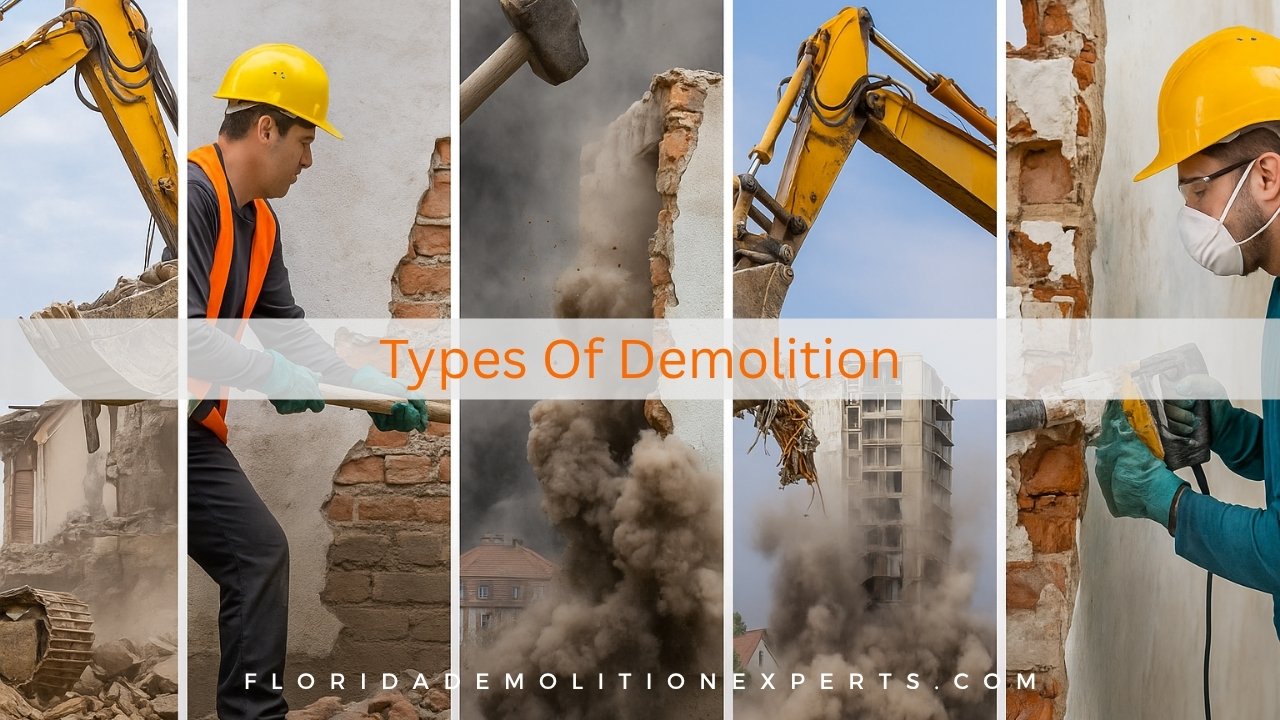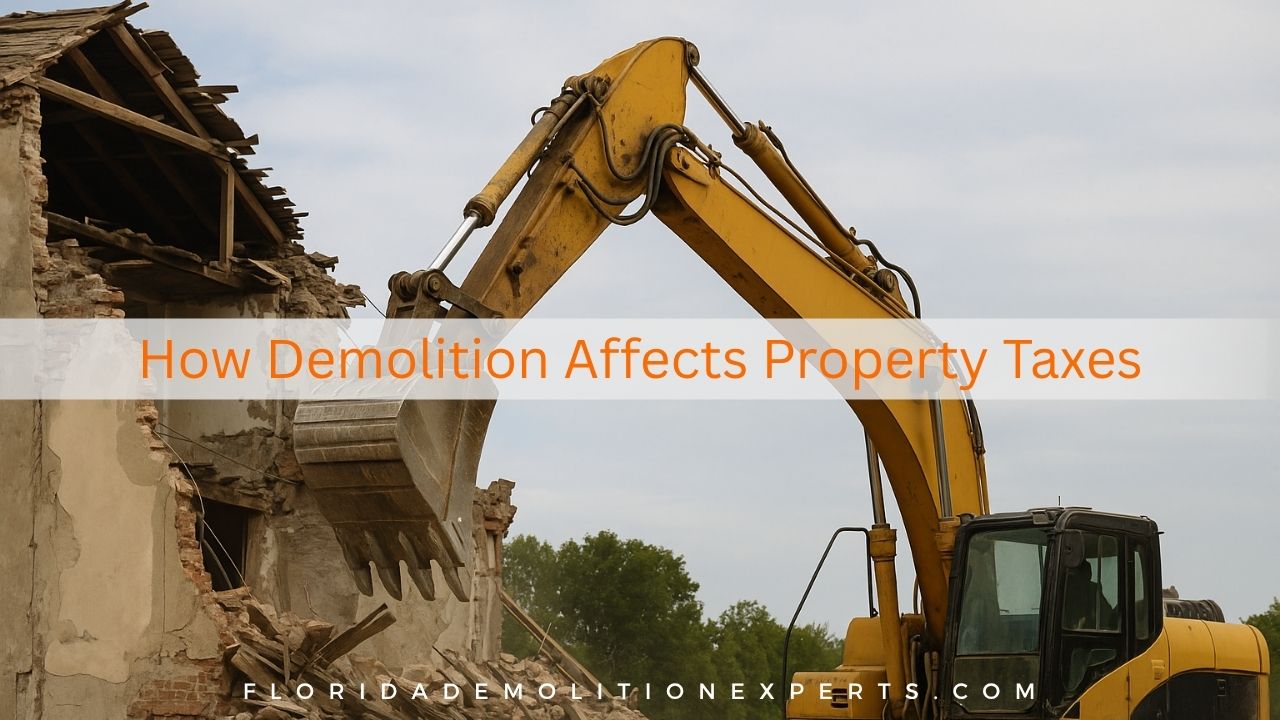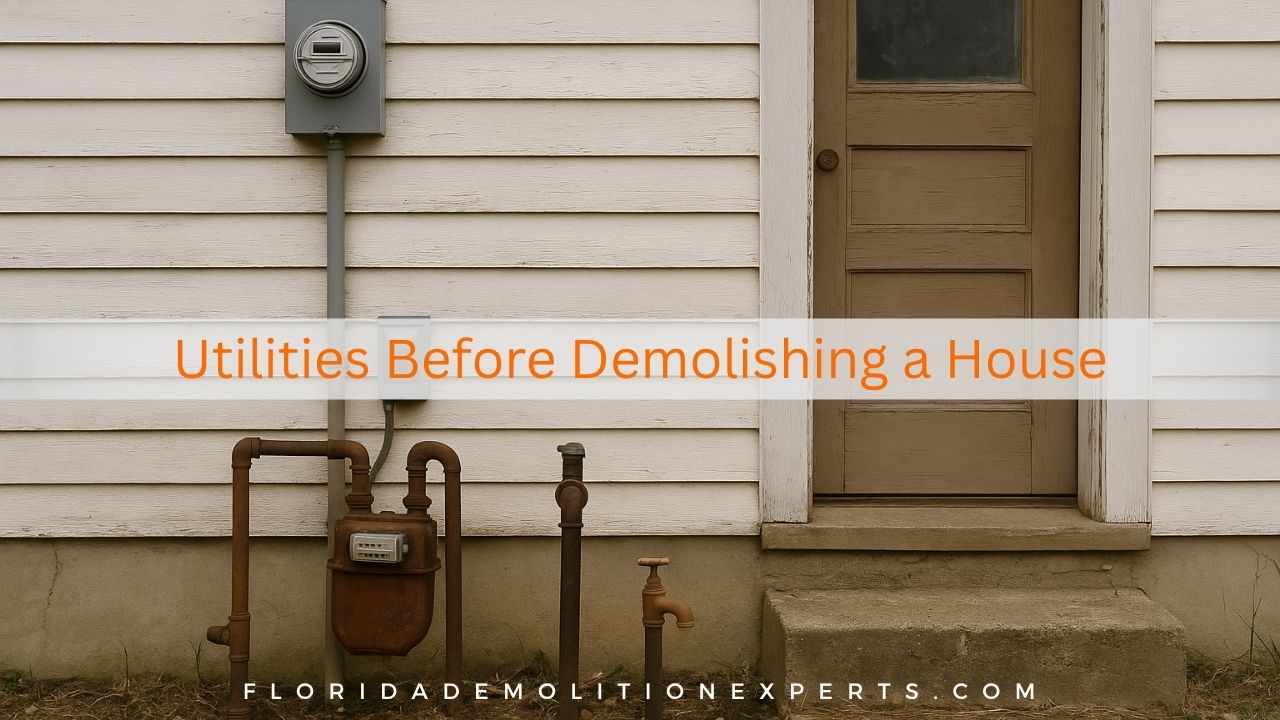Planning to demolish a structure but unsure which method suits your property best? Demolition isn’t just about smashing walls. Demolition isn’t just about smashing walls. If you’re new to the process, start by reading our complete residential demolition guide to get a broader understanding of what demolition involves. It’s a strategic, highly regulated process with multiple types designed to suit different structures, safety concerns, environmental conditions, and project goals. Whether you’re dealing with a high-rise building, a small house, or a selective interior teardown, understanding the different types of demolition methods help you choose the safest, most cost-effective solution.
This guide will explore the most common demolition methods in Florida and the U.S., explain when to use each, and highlight their advantages, techniques, and typical costs.
Types of Demolition
1. Mechanical Demolition
Mechanical demolition is the most common method for tearing down structures. It relies on heavy machinery such as hydraulic excavators, bulldozers, and cranes with specialized attachments like grapples, shears, or wrecking balls. This method is ideal for quickly and efficiently removing entire buildings, especially when space allows for equipment access.
Contractors typically use mechanical demolition for wood-framed houses, concrete block structures, and small commercial buildings. The process begins with a site inspection and utility disconnection, followed by systematic teardown and debris handling. Dust suppression and safety barriers are often used to control the impact on nearby properties.
When to Use:
- Complete structure demolition (residential or commercial)
- Properties with enough space for equipment access
- Projects requiring fast, high-volume teardown
Pros:
- Fast and efficient
- Cost-effective for larger buildings
- Suitable for a wide range of materials (wood, concrete, brick)
Estimated Cost: $6–$15 per square foot
2. Manual Demolition
Also known as hand demolition, this method involves using handheld tools such as sledgehammers, crowbars, chisels, and saws. It’s typically used when machinery access is limited or precision is critical. Because it doesn’t involve heavy equipment, manual demolition minimizes vibration, dust, and collateral damage.
This method is standard in densely populated urban neighborhoods or homes undergoing partial renovations. Manual demolition also allows for the selective removal of walls, ceilings, or fixtures without disturbing the structural frame.
When to Use:
- Small structures like sheds or interior renovations
- Areas with restricted access (urban sites, tight lots)
- Preservation of adjacent buildings
Pros:
- Precise and controlled
- Ideal for partial demolition
- Less disruptive to the surroundings
Estimated Cost: $10–$30 per square foot (labor-intensive)
3. Implosion (Explosive Demolition)
Implosion involves the controlled use of explosives to bring down large structures in seconds. This highly technical method requires in-depth structural analysis, precision engineering, and extensive safety planning. Charges are placed on key structural elements such as columns and beams so the building collapses inward, avoiding damage to nearby structures.
This method is usually reserved for multi-story buildings, obsolete factories, or condemned concrete structures where traditional equipment would be less practical or cost-effective. While it’s rarely used for residential buildings, implosion is a powerful solution for clearing large sites quickly.
When to Use:
- High-rise or multi-story buildings
- Industrial facilities or stadiums
- Dense urban areas with limited equipment access
Pros:
- Extremely fast
- Safe for complex structures (when properly executed)
Important: Only licensed explosive experts can perform this method. Local permits, environmental review, and evacuation planning are mandatory.
Estimated Cost: It varies greatly and is often priced by structure and complexity.
4. Deconstruction (Selective Demolition)
Deconstruction is a labor-intensive method that carefully dismantles a structure to recover valuable or reusable materials. Hardwood flooring, doors, windows, kitchen cabinets, copper piping, and light fixtures can be salvaged and reused on-site or donated for tax credits.
This method is ideal for homeowners or developers who prioritize sustainability or want to reduce landfill waste. Deconstruction also appeals to projects with architectural or historical significance, where preserving building elements is a priority.
Contractors typically begin by stripping the interior of reusable materials before removing structural elements one by one. This process takes longer than mechanical demolition but offers greater environmental and social returns.
When to Use:
- Green building projects
- Historic preservation
- Structures with valuable or reusable components
Pros:
- Environmentally friendly
- Tax benefits for material donations
- Minimal waste
Estimated Cost: $8–$20 per square foot (higher labor cost, but materials can offset expense)
5. Interior or Soft Demolition
Interior or soft strip demolition involves removing non-structural elements such as drywall, flooring, ceilings, lighting, HVAC systems, and plumbing. It’s typically done to prepare a space for renovation or remodeling, allowing construction teams to work from a clean slate.
Interior demolition requires precision to avoid damaging load-bearing walls or active systems that remain. Proper safety procedures are critical to protect both the crew and the structure. This method is often used in commercial tenant fit-outs, kitchen/bath remodels and office space conversions.
Debris must be sorted and disposed of properly, and all work must comply with building codes. Temporary containment and dust barriers are used to protect unaffected areas.
When to Use:
- Remodeling projects
- Tenant improvements
- Pre-renovation clean-up
Pros:
- Doesn’t compromise structure
- Quick turnaround
- Can be done alongside construction teams
Estimated Cost: $2–$10 per square foot
Choosing the Right Type of Demolition
Planning a home teardown in Florida? Discover how to choose the best demolition contractor to ensure a safe, smooth, and compliant process.. Selecting the best method depends on:
- Structure size and materials
- Location (urban vs suburban)
- Budget and timeline
- Environmental impact goals
- Accessibility of machinery
A professional contractor can assess your site and determine the safest and most cost-effective solution.
FAQs
What is the safest method of demolition?
Manual demolition and deconstruction are the safest due to their controlled, low-impact nature, but mechanical demo is also secure when performed by trained crews.
What is the difference between demolition and deconstruction?
Demolition tears down the structure quickly, while deconstruction salvages materials for reuse before dismantling.
Do I need a permit for demolition in Florida?
Yes, a permit is required for any structural demolition. Learn more in our Florida demolition permit guide.
Which demolition method is best for houses?
Mechanical demolition is usually the fastest and most cost-efficient for standard residential homes.
Can I demolish a house myself?
Only if you own the property, pull the proper permits, and follow all legal safety and environmental rules. For complete demolitions, experts strongly recommend hiring professionals
Final Thoughts
Demolition is never a one size fits all task. Each method has its place depending on your project’s needs, size, and environmental goals. Understanding the types of demolition ensures safer outcomes, better budgeting, and smarter project planning.
Florida Demolition Experts offers tailored demolition solutions across the state, from small interior teardowns to large-scale mechanical and selective deconstruction projects. Our licensed team handles everything: permits, safety protocols, debris removal, and efficient site clearing.






